A biosensor is a device that has the potential to detect a particular substance or analyte with high specificity. Examples of such analytes include glucose, lactate, glutamate and glutamine. Most biosensors are capable of measuring the concentration of an analyte in an aqueous solution, generally producing an electrical signal, which is considered to be proportional to the analyte’s concentration in its measuring range.
An enzymatic biosensor comprises of an enzyme, which recognizes and then reacts with the target analyte producing a chemical signal, a transducer, which produces a physical signal out of that chemical one, and an electronic amplifier, which conditions and then amplifies the signal.
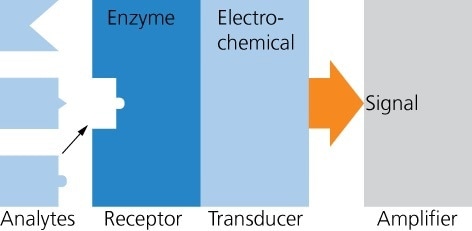
General structure of a biosensor. Sensors by IST AG use enzymes to detect glucose, lactate, glutamine and glutamate. The transducer principle is electrochemical, producing a current as output signal (amperometric).
Biosensors permit the analysis in complex biological media. The detection of a huge number of compounds is of immense relevance for scientific research and also for process control in the food and chemical industry. It is also indispensable in the health care field for the diagnosis and subsequent treatment of diseases and monitoring of illnesses. The biotechnology and pharmaceutical industries greatly desire frequent to continuous analysis of biological media.
Such analyses are performed with the help of analytical instruments such as HPLC systems, which, although reliable and robust, are expensive and have a limited suitability for online operation. For this reason, the acquisition of Jobst Technologies GmbH places IST AG as a key provider of reliable and high-performance online biosensors.
Enzymatic Biosensors for Metabolic Parameters
Back in the early 1960’s, Clark and Lyons launched the first glucose sensor employing an enzyme (glucose oxidase, GOx) as receptor, this enzyme being specific for glucose. Enzymes allow the highly specific measurement of their corresponding analyte even in complex mixtures like blood and fermentation broth; it is like finding a needle in a haystack.
Analytes such as lactate, glucose, glutamate, and glutamine play a vital role in the metabolism of living organisms. Glutamine and glucose support the cell function and growth; lactate is developed by cells and allows judging the efficiency of the cells metabolism; and glutamate is an amino acid consumed by cells. Each of these analytes needs a particular set of enzymes for its detection.
The constant (on-line) monitoring of the concentration of such parameters enables among numerous others
- the generation, optimization, and control of feeding strategies in cell cultures
- the minimization of patients’ risks during intensive care and surgery
- on-site analysis of food processes
Versatile Sensors
Jobst Technologies GmbH has decades of experience in enzymatic biosensors. Enzymes are known to be immobilized in a stack of four permeable polymeric membranes on top of platinum micro-electrodes, which pick up an electrical current developing from the enzymatic reaction. The superior membrane technology by Jobst Technologies enables easy tuning of performance parameters such as sensitivity, response time and measurement range. Furthermore, this technology is compatible with sterilization by irradiation (beta, gamma). All this enables the biosensors to be ideal for an extensive range of applications.
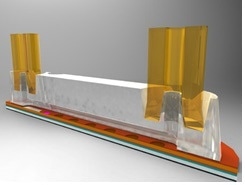
Cross section of a flow-through LV5 biosensor featuring a flow-through cell for measuring of glucose, lactate, glutamine and glutamate.
Thanks to the small size of the electrodes, a single chip is capable of holding several electrodes. The array sensor LV5 from Jobst Technologies features up to six sensitive electrodes where glucose, lactate, glutamate and glutamine can be simultaneously detected. Extremely small liquid samples can be examined as they flow via its 1-μL flow cell, thus being perfect for both offline analysis and online operation.
Finally, each sensor is factory calibrated and also marked in an automated process offering complete traceability making it perfect for single-use and ready-to-use applications.
Biomedical Application – A New Landmark Product: EIRUS
Optimal treatment of critically ill patients will need the continuous surveillance of their blood values. Recently, a globally leading provider of medical systems for hospitals, Maquet Critical Care, has been establishing a new standard by launching the EIRUS platform specifically developed for providing continuous monitoring of both lactate and glucose in critically ill patients. Besides optimizing patient care quality, it also decreases nurses’ workload compared to frequent intermittent blood analysis. This system depends on micro-dialysis technology that feeds a flow-through sensor produced and manufactured in Freiburg (Germany) by Jobst Technologies GmbH.
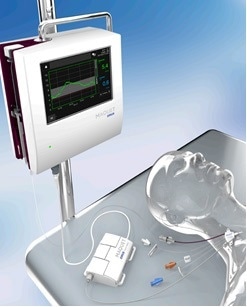
EIRUS system by Maquet for continuous monitoring of glucose and lactate in intensive care patients. Copyright: Maquet Critical Care
During several days of nonstop operation, EIRUS reports glucose and lactate blood levels every minute and raises alerts every time the values fall outside the preset ranges. This allows the rapid assessment of the patient’s glycemic condition, which in turn guarantees swift and prompt glucose management with insulin. Tighter glycemic control benefits not only diabetic patients but has also been shown to enhance outcome in non-diabetic critical care patients who often display a condition called ‘stress diabetes’.
Elevated lactate levels (hyperlactatemia) are an indicator of increased mortality and morbidity. Lactate monitoring allows an early and nonstop risk assessment, diagnosis, and therapy, reducing patients’ risks.
Biosensors – Their Application in Biotechnology
Presently, cell cultures help in the development of new drug and medication. Animal cells are engineered in order to express antibodies and proteins used in the treatment of several illness and conditions. In order to maximize product quality and yield, it is necessary for conditions of cell cultures to meet optimal values. Monitoring of nutrients, such as glucose, plays a significant role in the feeding strategy of a cell culture. One type of glucose sensors employed in biotechnology needs a fluidic-dilution stage that has to be outside the culture vessel.
Such systems show problems such as large latency due to the transit time via the dilution stage; more footprint since an external analyzer is needed; contamination risk as it is necessary to invasively take samples inside the bioreactor and deal with the dead volume in the tubes. It is not possible for other sensors to survive prolonged shelf storage after sterilization by irradiation. The technology developed by IST AG and Jobst Technologies permits continuous glucose monitoring either inside the culturing vessel or by through a probing system.
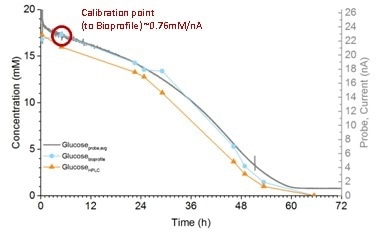
Comparison of glucose values during batch culture.
A Chinese-hamster-ovary (CHO) cell line was employed for a batch1 culture in a standard glass bioreactor. The glucose concentration was endlessly monitored for several days. For the control measurements, a HPLC system and a Nova Bioprofile Analyzer were used. Sensors can be gamma irradiated and stored before utilization due to their robustness. Sensors are precalibrated; however, a single calibration at start offers increased accuracy throughout the whole cultivation lasting days. During this time, a measurement point is attained every second without the need for any manual work as the used reference systems do.
Biosensors - Innovative Sensor Technology IST AG
1 In a batch culture, the nutrient medium has starting glucose concentration and no further nutrient feeding is performed.
Acknowledgments
Special thanks to Dr. Caspar Demuth, Dr. Iris Poggendorf, Fabienne Seiler and Irène Stutz from the Zurich University of Applied Sciences (Institute for Biotechnology, Wädenswil, Switzerland) for carrying out the cultivation and providing us with the data.
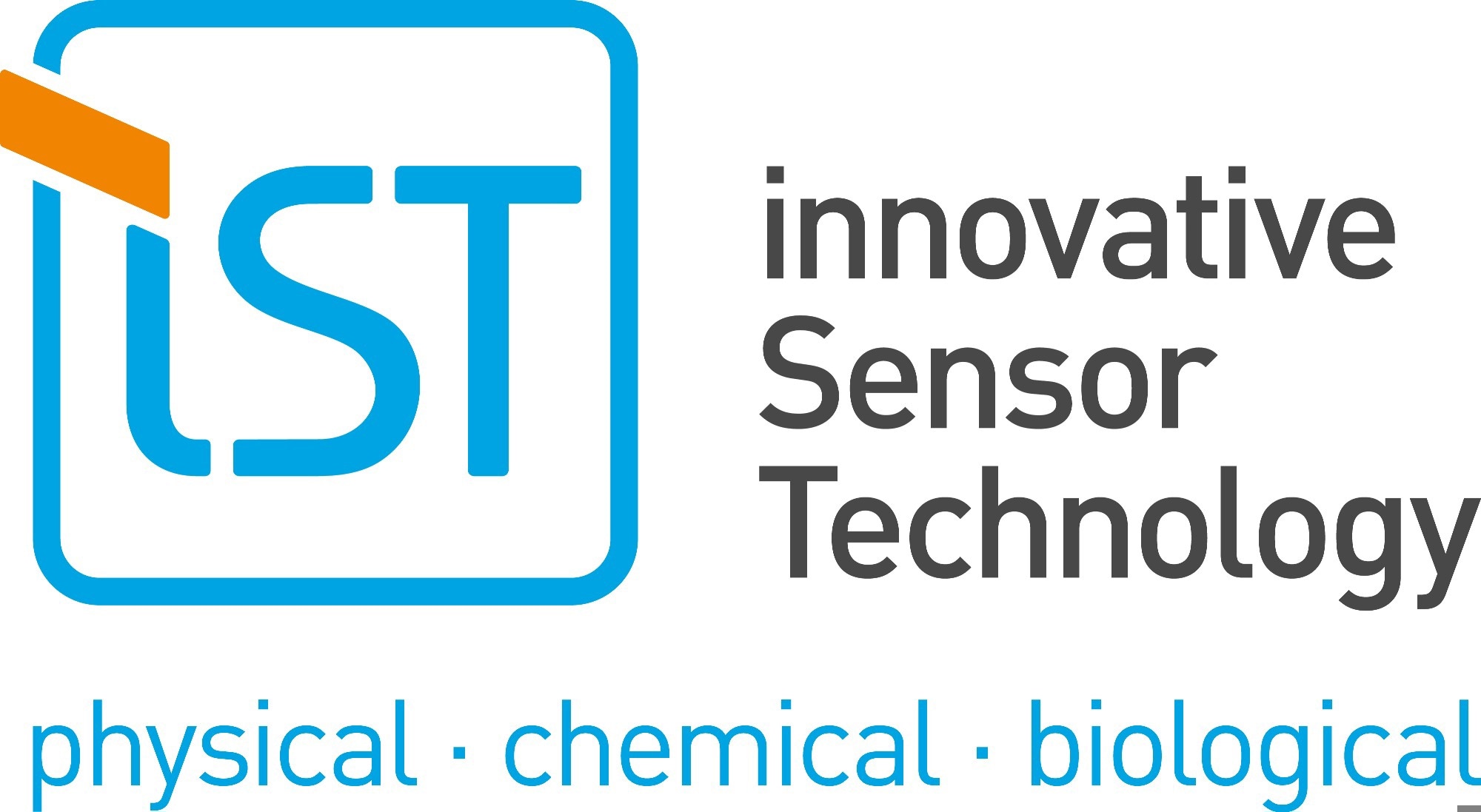
This information has been sourced, reviewed and adapted from materials provided by Innovative Sensor Technology, USA Division.
For more information on this source, please visit Innovative Sensor Technology, USA Division.